《机械原理》课程PPT教学课件(Theory of Machines and Mechanisms)Chap5 Gear Trains

Chap.5 Gear Trains Chap.5.1 Introduction Chap.5.2 The fundamental law of gearing Chap.5.3 Gear tooth nomenclature Chap.5.4 Condition for Correct Meshing Chap.5.5 Contact Ratio Chap.5.6 Interference and undercutting Chap.5.7 Gear types and Application Chap.5.8 Ordinary gear trains Chap.5.9 Epicyclic or planetary gear trains Chap.5.10 Applications of gear train
Chap.5 Gear Trains Chap.5.1 Introduction Chap.5.2 The fundamental law of gearing Chap.5.3 Gear tooth nomenclature Chap.5.4 Condition for Correct Meshing Chap.5.5 Contact Ratio Chap.5.6 Interference and undercutting Chap.5.7 Gear types and Application Chap.5.8 Ordinary gear trains Chap.5.9 Epicyclic or planetary gear trains Chap.5.10 Applications of gear train
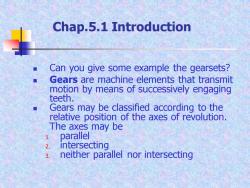
Chap.5.1 Introduction Can you give some example the gearsets? Gears are machine elements that transmit motion by means of successively engaging teeth. Gears may be classified according to the relative position of the axes of revolution. The axes may be 1. parallel 2 intersecting 3. neither parallel nor intersecting
Chap.5.1 Introduction ◼ Can you give some example the gearsets? ◼ Gears are machine elements that transmit motion by means of successively engaging teeth. ◼ Gears may be classified according to the relative position of the axes of revolution. The axes may be 1. parallel 2. intersecting 3. neither parallel nor intersecting
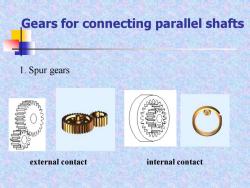
Gears for connecting parallel shafts 1.Spur gears external contact internal contact
Gears for connecting parallel shafts 1. Spur gears external contact internal contact

Gears for connecting parallel shafts 2.Parallel helical gears 3.Herringbone gears(or double-helical gears)
2. Parallel helical gears 3. Herringbone gears (or double-helical gears) Gears for connecting parallel shafts
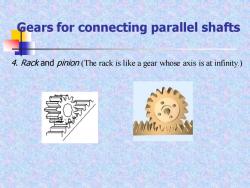
Gears for connecting parallel shafts 4.Rack and pinion(The rack is like a gear whose axis is at infinity.)
4. Rack and pinion (The rack is like a gear whose axis is at infinity.) Gears for connecting parallel shafts

Gears for connecting intersecting shafts 1.Straight bevel gears 2.Spiral bevel gears
Gears for connecting intersecting shafts 1. Straight bevel gears 2. Spiral bevel gears
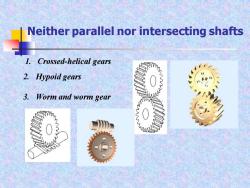
Neither parallel nor intersecting shafts 1. Crossed-helical gears 2.Hypoid gears 3.Worm and worm gear
Neither parallel nor intersecting shafts 1. Crossed-helical gears 2. Hypoid gears 3. Worm and worm gear
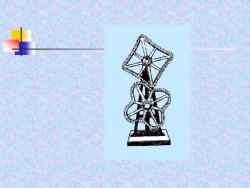
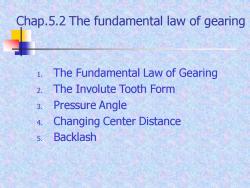
Chap.5.2 The fundamental law of gearing 1. The Fundamental Law of Gearing 2. The Involute Tooth Form 3. Pressure Angle 4 Changing Center Distance 5. Backlash
Chap.5.2 The fundamental law of gearing 1. The Fundamental Law of Gearing 2. The Involute Tooth Form 3. Pressure Angle 4. Changing Center Distance 5. Backlash
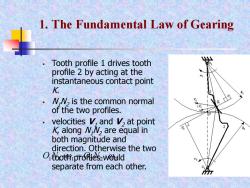
1.The Fundamental Law of Gearing Tooth profile 1 drives tooth profile 2 by acting at the instantaneous contact point K. M,N,is the common normal of the two profiles. velocities V,and V,at point K,along N,N,are equal in both magnitude and direction.Otherwise the two Otootiprofleszwould separate from each other
▪ Tooth profile 1 drives tooth profile 2 by acting at the instantaneous contact point K. ▪ N1N2 is the common normal of the two profiles. ▪ velocities V1 and V2 at point K, along N1N2 are equal in both magnitude and direction. Otherwise the two tooth profiles would separate from each other. 1. The Fundamental Law of Gearing 1 1 1 2 2 2 O N = O N
按次数下载不扣除下载券;
注册用户24小时内重复下载只扣除一次;
顺序:VIP每日次数-->可用次数-->下载券;
- 《机械原理》课程PPT教学课件(Theory of Machines and Mechanisms)Chap4 Cam Mechanism.ppt
- 《机械原理》课程PPT教学课件(Theory of Machines and Mechanisms)Chap3 planar linkage.ppt
- 《机械原理》课程PPT教学课件(Theory of Machines and Mechanisms)Chap2 Kinematics fundamental.ppt
- 《机械原理》课程PPT教学课件(Theory of Machines and Mechanisms)Chap1 Theory of Machines and Mechanisms.ppt
- 《机械原理》课程教学资源(作业习题)机械原理作业(英语,无答案).doc
- 《机械原理》课程教学资源(作业习题)第十章 齿轮系及其设计(含答案).doc
- 《机械原理》课程教学资源(作业习题)第六章 机械运转与速度波动的调节(含答案).doc
- 《机械原理》课程教学资源(作业习题)第八章 凸轮机构及其设计(含答案).doc
- 《机械原理》课程教学资源(作业习题)第五章 机械的平衡(含答案).doc
- 《机械原理》课程教学资源(作业习题)第九章 齿轮机构及其设计(含答案).doc
- 《机械原理》课程教学资源(作业习题)第七章 平面连杆机构及其设计(含答案).doc
- 《机械原理》课程教学资源(作业习题)第四章 机械的效率和自锁(含答案).doc
- 《机械原理》课程教学资源(作业习题)第二章 平面机构的运动分析(含答案).doc
- 《机械原理》课程教学资源(作业习题)第三章 平面结构力分析(含答案).doc
- 《机械原理》课程教学资源(作业习题)第一章 机构的组成原理与结构分析(含答案).doc
- 新疆大学:《机械原理》课程教学资源(作业习题)机械原理各章习题集(无答案).doc
- 新疆大学:《机械原理》课程教学资源(实验指导)机械原理课程设计题目汇编.doc
- 新疆大学:《机械原理》课程教学资源(实验指导)机械原理课程设计(PPT讲稿).ppt
- 新疆大学:《机械原理》课程教学资源(实验指导)课程设计指导.doc
- 新疆大学:《机械原理》课程教学资源(实验指导)机械原理实验教程.doc
- 《机械原理》课程PPT教学课件(Theory of Machines and Mechanisms)Chap6 intermittent mechanisms.ppt
- 《机械原理》课程PPT教学课件(Theory of Machines and Mechanisms)Chap8 Application.ppt
- 《机械原理》课程PPT教学课件(Theory of Machines and Mechanisms)Chap10 Scheme of Mechanism system.ppt
- 新疆大学:《机械原理》课程教学课件(PPT讲稿)第三章 平面机构的运动分析.ppt
- 新疆大学:《机械原理》课程教学课件(PPT讲稿)第二章 机械的结构分析.ppt
- 新疆大学:《机械原理》课程教学课件(PPT讲稿)第五章 机械的效率和自锁.ppt
- 新疆大学:《机械原理》课程教学课件(PPT讲稿)第一章 绪论 Theory of Machines and Mechanisms.ppt
- 新疆大学:《机械原理》课程教学课件(PPT讲稿)第七章 机械的运动及其速度波动的调节.ppt
- 新疆大学:《机械原理》课程教学课件(PPT讲稿)第九章 凸轮机构及其设计.ppt
- 新疆大学:《机械原理》课程教学课件(PPT讲稿)第八章 平面连杆机构及其设计(1/2).ppt
- 新疆大学:《机械原理》课程教学课件(PPT讲稿)第八章 平面连杆机构及其设计(2/2).ppt
- 新疆大学:《机械原理》课程教学课件(PPT讲稿)第六章 机械地平衡.ppt
- 新疆大学:《机械原理》课程教学课件(PPT讲稿)第十一章 齿轮系及其设计.ppt
- 新疆大学:《机械原理》课程教学课件(PPT讲稿)第十二章 其他常用机构.ppt
- 新疆大学:《机械原理》课程教学课件(PPT讲稿)第十四章 机械系统的方案设计.ppt
- 新疆大学:《机械原理》课程教学课件(PPT讲稿)第十章 齿轮机构.ppt
- 新疆大学:《机械原理》课程教学课件(PPT讲稿)第四章 平面机构的力分析.ppt
- 《机械制造技术基础》课程教学资源(教案讲义)第三章 金属切削机床.doc
- 《机械制造技术基础》课程教学资源(教案讲义)第五章 机械加工质量及其控制.doc
- 《机械制造技术基础》课程教学资源(教案讲义)第一章 绪论、第二章 切削过程及其控制.doc
